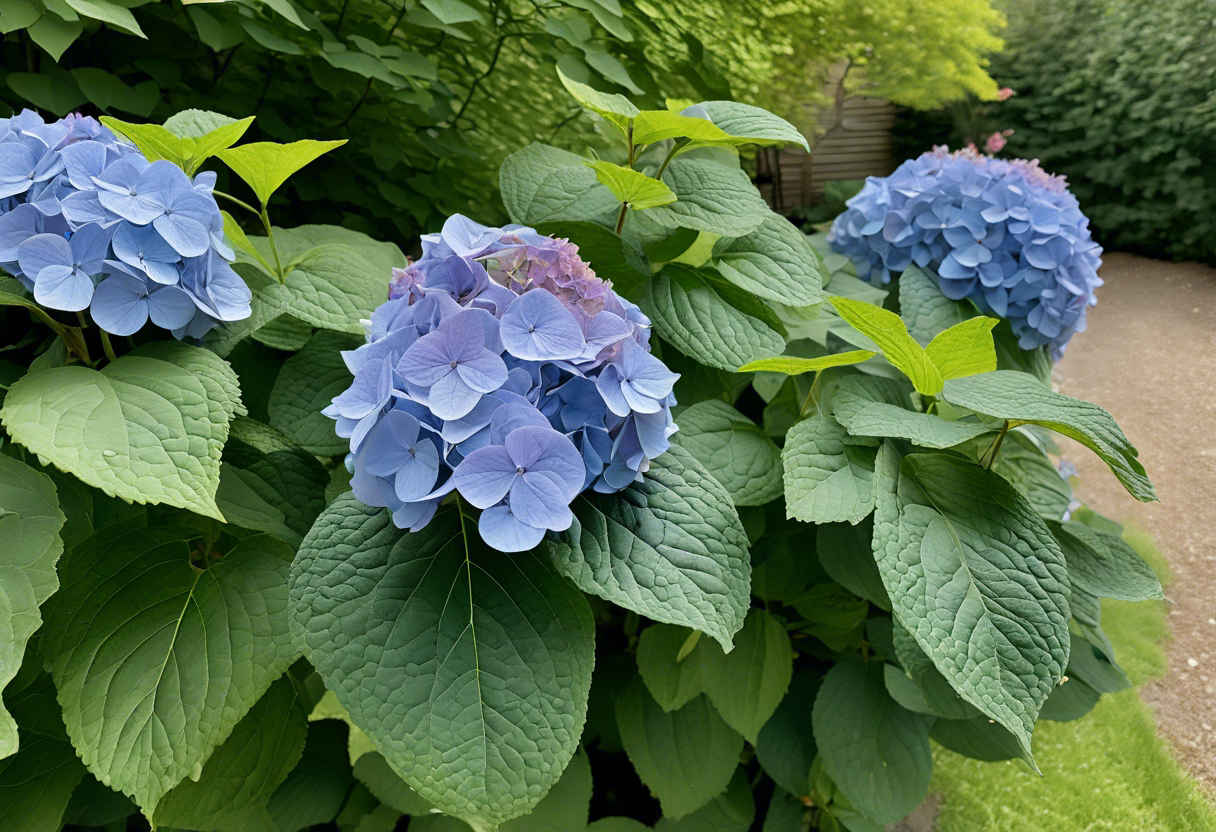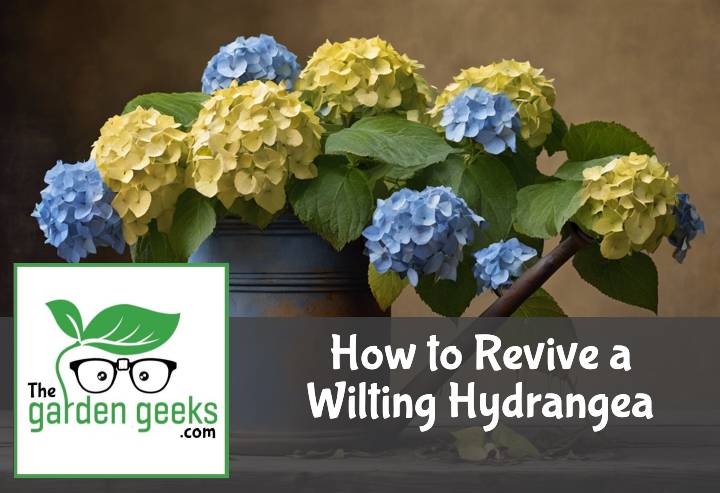Ever looked at your garden and thought, “Well, that’s not a happy hydrangea!”? I’ve been there – sipping my morning coffee, only to spot my once vibrant hydrangea looking all droopy and sad. If you’re in the same boat, fret not! This guide on How to Revive a Wilting Hydrangea will help you nurse your plant back to its blooming glory.
Now you might be thinking, ‘Can’t plants just sort themselves out?’ Well, sometimes they need a little bit of TLC from us humans. So let’s roll up our sleeves and dive into the world of hydrangeas! Keep reading about How to Revive a Wilting Hydrangea.
Key Takeaways
- Identify wilting signs in hydrangeas like drooping leaves and browning edges.
- Hydrate the plant immediately by soaking the roots in water for about 45 minutes.
- Trim off any dead or dying flowers to redirect energy to healthier parts of the plant.
- Ensure proper sunlight exposure, ideally morning sun and afternoon shade.
- Maintain soil pH between 5.5 and 6.5 for optimal growth.
- Regularly check for pests or diseases that may cause wilting.

Understanding Hydrangea Health
When it comes to hydrangea care, it’s crucial to know your plant like the back of your hand. Recognizing signs of an unhealthy hydrangea can be the difference between a blooming beauty and a wilting wallflower. We’re talking about maintaining hydrangea health and, more importantly, reviving wilted hydrangeas.
Identifying Signs of a Wilting Hydrangea
So, how do you spot a wilting hydrangea? It’s all in the leaves, my friend! If they’re drooping or turning yellow, that’s your first clue. These are classic wilting hydrangea symptoms.
But don’t stop at the leaves. Check out the blooms too. If they’re looking less than perky, you might be dealing with an unhealthy plant. Remember, we’re not just spotting unhealthy hydrangeas here; we’re diagnosing them!
Common Causes for Wilting in Hydrangeas
Now that we’ve covered how to identify a wilting hydrangea let’s delve into why this happens. One common culprit is environmental stress on plants. Too much sun or not enough water can leave your plant feeling under the weather.
But sometimes it’s not so simple. Diseases can also cause wilting in our green friends. So if you’ve been taking care of your plant and it’s still looking sad, disease could be to blame.
Remember folks, understanding these factors causing plant wilt is key in learning how to revive a wilting hydrangea!
Assessing Your Wilting Hydrangea

So, you’ve got a wilting hydrangea on your hands. Don’t panic! It’s time to play plant detective. The first step in reviving wilted hydrangeas is a thorough hydrangea assessment. We’re talking about examining its environment and checking for any nasty diseases or pests.
Examining the Plant’s Environment
Alright, let’s start with the surroundings of your droopy friend. The hydrangea environment plays a crucial role in its health. Check out the light exposure – too much sun can be as harmful as too little for these guys. Next up, inspect the soil quality. Hydrangeas are picky eaters; they prefer well-drained, rich soil. And don’t forget about watering! Overwatering or underwatering can lead to wilting faster than you can say “watering hydrangeas“.
Checking for Diseases or Pests
Now onto the less pleasant part – looking for diseases or pests. These sneaky buggers can cause all sorts of common hydrangea problems. Look out for spots, discoloration, or anything that just doesn’t look right on your plant during this plant health check. If you spot any signs of disease or pest infestation in your hydrangeas, it’s time to take action! But remember, figuring out how to revive a wilting hydrangea isn’t rocket science – it’s more like plant CSI!

Reviving Techniques for a Wilting Hydrangea
Proper hydrangea care is the key to bring back your wilting hydrangea to life. It’s all about adjusting watering practices and tweaking light and temperature conditions. Remember, how to revive a wilting hydrangea isn’t rocket science, it just requires a little bit of love and attention.
Adjusting Watering Practices
So, you’ve got a thirsty (or maybe too waterlogged) hydrangea on your hands? No worries! Your hydrangea watering guide starts here. Overwatered hydrangeas often show similar symptoms as underwatered ones – think yellow leaves and droopy blooms. The trick is to find the optimal watering for hydrangeas, which usually means keeping the soil moist but not soggy.
Modifying Light and Temperature Conditions
Next up, let’s talk about light and temperature. Hydrangeas aren’t sun worshippers or frost fans, so finding the right balance is crucial. The ideal temperature for hydrangeas is around 70°F during the day with a slight drop at night. As for light, they need bright but indirect sunlight. So if you’re looking to improve your hydrangea light requirements, consider moving them to an east or north-facing window.
Nutrient Management for Healthy Hydrangeas
When it comes to hydrangea care, one can’t overlook the importance of nutrient management. It’s like a secret sauce that keeps your hydrangeas blooming and vibrant. The key components here are soil nutrients, pH balance, and proper fertilization techniques.
Importance of Soil pH for Hydrangeas
Hydrangeas are pretty picky about their soil conditions. They’re like those fussy eaters who won’t touch anything unless it’s just right. The soil acidity or alkalinity (known as pH) plays a significant role in hydrangea growth.
Now, you might be wondering how to figure out your soil’s pH level. Well, you can use a simple pH testing kit available at any garden store. Once you know where your soil stands on the pH scale, you can take steps towards adjusting it if necessary.
If your hydrangea is throwing tantrums and not growing well, it might be because of an imbalanced pH level. Fear not! You can adjust the pH by adding specific amendments to the soil.
Fertilizing Your Hydrangea Correctly
Just like us humans need food to grow and stay healthy, plants need their nutrition too! And that’s where fertilizers come into play. But remember folks, not all fertilizers are created equal when it comes to hydrangeas.
Choosing the right hydrangea fertilizer is crucial for plant health. Organic fertilizers are great as they release nutrients slowly over time providing a steady supply of nutrition to your hydrangeas.
Timing is another important factor in fertilizing your hydrangeas correctly. A good rule of thumb is to follow a regular fertilizing schedule, typically once in spring and again in late summer.
So there you have it folks! Proper nutrient management is key in learning how to revive a wilting hydrangea. With the right soil pH and fertilization, your hydrangeas will be back to their blooming best in no time!
Preventive Measures to Avoid Future Wilting
Prevention is always better than cure, right? This saying holds true when it comes to hydrangea care. To keep your hydrangeas happy and prevent future wilting, you need to focus on two main things: regular monitoring and choosing the right location for planting.
Regular Monitoring and Care
Keeping a close eye on your hydrangeas can make all the difference in preventing wilting. You know what they say, “A watched pot never boils.” Well, a watched hydrangea rarely wilts!
Now, let’s talk about watering. Hydrangeas love water but don’t drown them! Stick to a consistent hydrangea watering schedule. Too much or too little water can lead to wilting.
Next up is pruning. Pruning isn’t just for haircuts, folks! Regularly pruning hydrangeas helps promote healthy growth and prevents disease spread that could cause wilting.
And don’t forget about pests. Those little critters can wreak havoc on your plants if left unchecked. So, stay on top of pest control for hydrangeas.
Choosing the Right Location for Planting
Location, location, location! It’s not just important in real estate; it’s crucial for plant health, especially when we’re talking about hydrangeas.
First off, consider sunlight exposure. Hydrangeas enjoy some sunbathing but not too much. Understanding your hydrangea sunlight needs will help you choose the best spot in your garden.
Soil quality is another biggie. The best soil for hydrangeas is rich and well-draining. So before you plant those beauties, make sure you’ve got the best soil for hydrangeas ready to go!
Lastly, think about where exactly you’re going to plant these guys. Not all spots in your garden are created equal. So, figure out where to plant hydrangeas for the best chance at a wilting-free future!

To Wrap Up
So, we’ve journeyed through the Hydrangea ER together, and now you’re all set with your green thumb toolkit on How to Revive a Wilting Hydrangea. Remember, it’s like making pancakes for breakfast; timing, temperature, and tender love are key!
Don’t let your hydrangeas turn into botanical zombies. Keep them vibrant and vivacious! Go out there and show ’em who’s boss of the blossom. Happy hydrangea healing!


